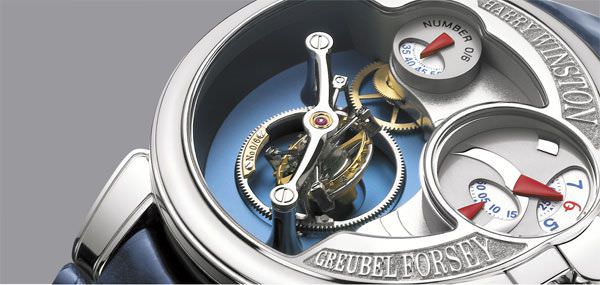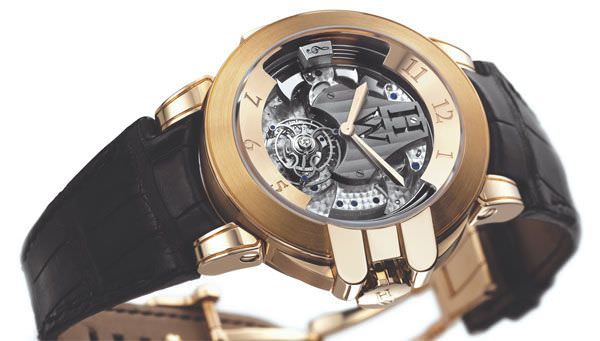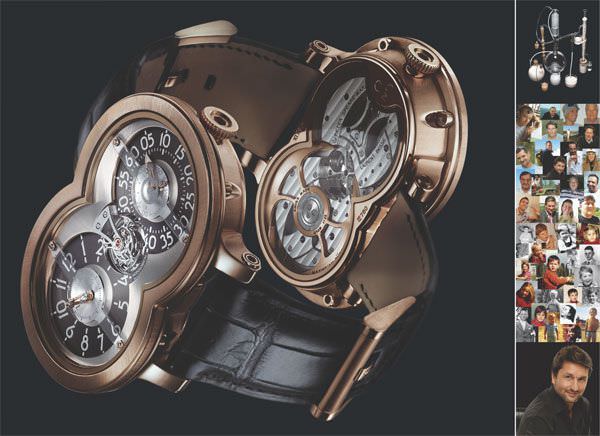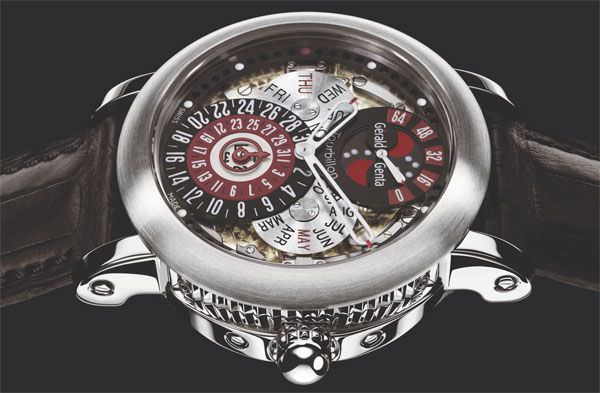The latest watch presented by Harry Winston (on the occasion of the inauguration of the brand’s new showroom in London), the Westminster Tourbillon, is perfectly emblematic of the ‘glam’ and the watchmaking path being followed by the diamond brand. “Our watchmaking strategy is simple,” explains Hamdi Chatti, CEO of Harry Winston Rare Timepieces. “On one side, we have our jewellery that tells time, veritable jewels that indicate the hour, while on the other side, we have our haute horlogerie timepieces, which are always unconventional and always display the highest watchmaking expertise. These include: our retrograde display line, which is emblematic of our originality; the totally innovative watches in the Opus collection; our Z sports line, also exceptional because it is made in a unique metal, Zalium; and lastly, a series of totally exclusive products that are intended to clearly confirm our position at the summit of the watchmaking pyramid, all created in a spirit similar to the Opus VI.”

OPUS VI by Greubel Forsey for Harry Winston
We all remember that this famous Opus VI, fruit of the formidable talent of Robert Greubel and Stephen Forsey, does not have a dial, which lets its 30-degree double tourbillon be shown off in all its glory. The watch resembles a sort of sculpture that tells time. It is in this particular spirit that Harry Winston intends to conduct its techno-aesthetic research in timekeeping. “These watches,” continues Chatti, “are more of a mechanical art object than a ‘belle’ watch such as those that we think of traditionally. This means watches whose design is the most technically advanced possible. Ideally, we want to eliminate the form and idea of a dial. The face of the watch thus becomes the direct expression of its functions.”

The WESTMINSTER TOURBILLON by Harry Winston
A ‘floating’ tourbillon
In a wonderfully successful demonstration of this mind set, we can admire the brand’s Westminster Tourbillon, developed in collaboration with Christophe Claret. The piece evokes rigorous simplicity, with its completely open flying tourbillon, which seems to almost float in the air. The gear train is not visible, but is hidden under a large central bridge decorated with a cut-out design of the brand’s initials. This openness offers a great view of the four cathedral gongs located around the case, as well as their hammers. The four gongs are made from Sandvik steel, and chime the same notes as London’s famous Westminster carillon (do, re, mi and so), which are faithfully reproduced. The quality and transmission of the sound are excellent, helped by the very precise and delicate craftsmanship of the gold case, as well as the airy structure of the movement. Very importantly, one of the gong heels is directly in contact with the sapphire crystal at 9 o’clock (and is decorated with the treble clef signature), thus amplifying the sound (a technique initiated by Jaeger-LeCoultre in its Master Minute Repeater Antoine LeCoultre).
“We do not like to use the word ‘complication’,” insists Hamdi Chatti, “because true art must seem to be of the highest simplicity. What is complex, however, is the development, the long hours of work needed to succeed in getting the simplest expression.” To support his words, Chatti uses an example of the great painters, such as a Picasso or a Matisse who, at the summit of their art, were able to draw the line of a face with an apparently juvenile simplicity. “Ah, but what work it took them to be able to arrive at this extreme simplicity,” he adds. The approach towards simplicity is skilfully incarnated in Harry Winston’s Westminster Tourbillon. If the face of the watch seems disarmingly simple, you only need to turn it over to see, in the tight intertwining of the many component parts, the complexity of what it took to arrive at this result.
“This watch foreshadows what we want to do,” says Chatti. “It exemplifies the masterpieces in which the function itself is the aesthetic expression of the piece. While this type of piece is a headache to create, the end result is worth all the pain. These projects also bring together all the strengths of our enterprise.” In June 2007, Harry Winston will inaugurate its new manufacture where its various competencies will be united under one roof. “We don’t say that we are a manufacture,” declares Hamdi Chatti. “We prefer to explain that we are gradually integrating all of our different métiers but that our development also involves sharing the savoir-faire with our long-time partners, who are the best. This is a perpetual, dynamic, lively, and always open exchange, which permits us to harmoniously develop our ‘unconventional’ products.” (Europa Star will return to the creation of this new watchmaking entity in a later issue.)
The utopia of MB&F
‘Unconventional’ is that and more, which the new entity called MB&F promises to offer in its pursuit of haute horlogerie. Behind these mysterious initials is the name of Maximilian Büsser, the predecessor of Hamdi Chatti at the head of Harry Winston Rare Timepieces, where he had notably launched the innovative Opus series. Encouraged by this new concept, Maximilian Büsser left Harry Winston to start his own company. His goal is to expand on these ideas by actively collaborating with the most creative young watchmakers and designers in the field, to open up new terrain in the art of timekeeping. The initials MB&F thus stand for Maximilian Büsser & Friends.

HOROLOGICAL MACHINE N°1 by Maximilian Büsser & Friends
In Büsser’s mind, the image that best defines what he intends to create is an alembic, a method of distilling the best ideas in common, of closely unifying the various competencies in order to succeed in creating the most surprising and the most innovative watch propositions of the moment. Maximilian Büsser himself defines his brand as a “utopia company” where he will only work with people who are his friends. While generating a sufficient income, the enterprise will remain a small and flexible unit, far from the infernal race for results and growth at any price. “The creation of MB&F was more of a lifestyle decision,” muses Maximilian Büsser, “than a cold and rational business computation. But the risks were nonetheless carefully calculated. Each year, MB&F will launch, alternately, a complex movement or a totally original module in a limited series, whose delivery will be spaced over three years each time. In this way, the revenue will progressively fund new research and creations. In terms of pieces created annually, the numbers are modest. The first year, we will make 30 pieces, of a total of 100 pieces of this particular model over a period of three years, and so on. We are clearly looking at a very particular niche market, one that desires the most innovative timepieces of haute horlogerie, and one that we don’t need to develop because it will arise all by itself, if we can say that…”
Third dimension
But just how could MB&F products be so different and so creative? The key phrase here is certainly ‘third dimension’. As we know, the latest Opus initiated at Harry Winston by Maximilian Büsser, and created by the young watchmaker Félix Baumgartner, explored the radically new way of using three dimensions to obtain a completely new form of display. Using three dimensions is how MB&F intends to create what Büsser calls Horological Machines. It is important to understand the radical and specific nature of this approach. This is not at all about merely proposing some surprising designs (that would be like “adding a spoiler and wings to an assembly-line car,” says Maximilian Büsser with a note of irony in his voice). Rather, it involves integrating the functions, material, and case all in the same movement. “It is not about creating design for design’s sake,” he comments. “Instead we want to explore, in the most integrated way possible, new horizons in terms of display, functions, energy, and fundamental watchmaking research.”
The first demonstration is the Horological Machine No 1. The name ‘machine’ is quite apt. Its sculptural case (41mm in height, 64mm in length, and 14mm in thickness), contains two distinct and tiered dials that are separated by a raised tourbillon, permitting the viewer to see its operation not only on the surface but also in depth. Yet, this ‘machine’ has a totally original face. With the hours on one side, and the minutes and power reserve indicator on the other side, it is clear they are all separated from each other. The ensemble is carried along by a totally original movement made up of 376 component parts and 81 jewels, designed and constructed by Laurent Besse in collaboration with Peter Speake-Marin. With its perfect level of finishing, the movement comprises four barrels, synchronized by a double gear train and mounted in parallel either by the rotor or by the crown. This unusual system allows for a reduction in the torque of each spring, an improvement in the isochronism, all while providing a power reserve of seven days.
One of the great strengths of MB&F is to not only introduce a completely innovative product, but to distribute it on an international scale, thanks to the network built up by Maximilian Büsser over the years. The thirty pieces anticipated for 2007 (available only in yellow or white gold, at a price of around 150,000 CHF) should have no problem in finding buyers (if they haven’t already). Currently, four other projects in various stages are in the MB&F pipeline. This autumn, the brand will present its second model. This is not a new movement, but an original additional module, whose price will be in the neighbourhood of 50,000 CHF. An adventure is born, and we look forward to discovering the next developments that promise even more in haute horlogerie.
A piano played with four hands
There is a whole other face, a whole other look at Gérald Genta, where design is not a function of the appearance of the piece (even if the look is particularly striking at Gérald Genta). “We want the design to be based on the movement,” explains Gérald Roden, CEO of the brand (as well as that of Daniel Roth, which along with Gérald Genta belong to the Bulgari group). “By starting with the movement, we can then transcribe it to the face of the watch. It also works the other way around, because the movement itself will draw inspiration from the face of the watch.”
As an example of this creative approach, Gérald Roden shows us the Arena Tourbillon Perpetual Calendar Lunar Phases. In this piece, the dial, in the traditional sense of the term, has disappeared in order to show off the elements of the movement (but not the tourbillon itself), which are decorated and finished in the traditional manner. On the movement, in a tiered and three-dimensional manner, are the various circular plates that carry the different indications. Their design is very contemporary, providing a contrast with the classic finishing of the movement. The piece’s aesthetic appeal comes from the tension between the classic and modern look as well as the tri-dimensionality of the collared displays. However, Gérald Roden says that, although this piece has already opened new design avenues, it is only the first step towards the integration, we could say, of the work on the movement and the dial (or what is left of the dial).
To convince us of this, he reveals the first drawings of a new skeleton watch which has been prepared for Daniel Roth, and which will be presented at the next BaselWorld. Traditionally, an artisan takes a movement and turns it into a ‘skeleton’ by cutting out the largest number of its component parts. But in the case of this new timepiece, the process is totally ‘integrated’ since the movement itself has been designed from the beginning to be a ‘skeleton’. Thus, for example, the bridges have been planned to offer an absolute lightness, giving a completely original piece that seems to be astoundingly simple and weightless.

ARENA TOURBILLON PERPETUAL CALENDAR LUNAR PHASES by Gérald Genta
“We do not claim to be revolutionizing watchmaking,” explains Roden, “but, in our own way, we are changing the way to work in it. To succeed, we have modified our creative approach by putting a designer and a technical constructor together at the same table, right from the beginning. This is not always evident, but we firmly believe that this work, commonly thought out from the first step, will result in pieces that diverge from the traditional approach, in other words from a movement placed in a case and protected by a dial. For our movements, the case and dial are designed at the same time, a little like a piano that is played with four hands.”
There can be no doubt that in this type of reasoning will be found the most interesting avenues in the new haute horlogerie.
Source: Europa Star October-November 2006 Magazine Issue





